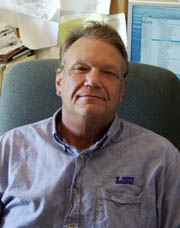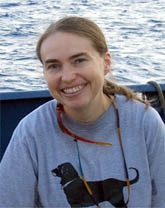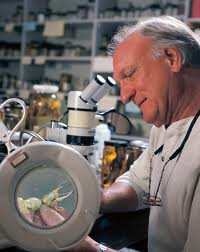It looks like you're using an Ad Blocker.
Please white-list or disable AboveTopSecret.com in your ad-blocking tool.
Thank you.
Some features of ATS will be disabled while you continue to use an ad-blocker.
"The fishermen have never seen anything like this..." Gulf seafood deformities alarm scientists
page: 4share:
I have been trying to avoid eating farm raised fish, but with the gulf oil spill and fukushima, wildcaught isn't looking much better.
Maybe it's time for people to start raising their own fish. I saw this on the news the other night and it got me thinking that this may be the only safe alternative soon.
Bronx Best Blue Tilapia - Video
Bronx Best Blue Tilapia - Article
Maybe it's time for people to start raising their own fish. I saw this on the news the other night and it got me thinking that this may be the only safe alternative soon.
Bronx Best Blue Tilapia - Video
Bronx Best Blue Tilapia - Article
edit on 18-4-2012 by MaryStillToe because: (no reason given)
reply to post by DragonFire1024
Excellent...
Usually, natural forces like storms and Hurricanes do a good job of flushing out any built up algae, silt, toxins, whatever.
This time however, the next major storm to strike the gulf will swoop up all that crap on the bottom and drive it ashore for the wetlands and man to choke on. Like you said, not if, but when.
So far there has not been a major hurricane to strike the gulf, right? And they will try to cover the resulting mess up then too.
Excellent...
Wait until all that sunken oil resurfaces. It's not a matter of if, but when...and where.
Usually, natural forces like storms and Hurricanes do a good job of flushing out any built up algae, silt, toxins, whatever.
This time however, the next major storm to strike the gulf will swoop up all that crap on the bottom and drive it ashore for the wetlands and man to choke on. Like you said, not if, but when.
So far there has not been a major hurricane to strike the gulf, right? And they will try to cover the resulting mess up then too.
With news like this about massive biological deformities in fish and crabs and other little guys showing up in the gulf, added to the other threads
about the state of eating "meat" and "seafood", I'm a little surprised everybody on ATS isn't happily vegetarian by this time. Maybe this thread
will give the corpsearians out there a bit of pause next time they see the poor things from the sea laid out on ice at the local market.
And I guess the shrimp with no eyes and crabs with weak shells now have an even harder time avoiding the massive nets that the boats drag along the Gulf floor to scoop up its inhabitants.
And I guess the shrimp with no eyes and crabs with weak shells now have an even harder time avoiding the massive nets that the boats drag along the Gulf floor to scoop up its inhabitants.
Why not just go Fishing for fresh water fish? Does anyone fish anymore ? Well, I for have not done this in 15 years and I know would be lots of
fun.
I don't know about you folks, but I always find stories from Al Jazeera suspect due to the fact they run false anti-American propaganda in their
operations in the Middle-East and in Africa. Due to that I first look for papers when it involves something like this that may be false or come from
crackpots.
I can't find a paper on this associated with the linked experts in the article. Have any of you found even one to verify the voracity of the story?
As was mentioned earlier the genetic defects could not have been caused by the spill and would take generations if not hundreds of years to develop, along with constant exposure. Since natural petroleum leaks in the Gulf produce more than the spill did every year, this simply does not ring true. Question is, do people want the truth or lies to support their fears even if they are false?
If you guys putting up all the flags have links to the published papers by the mentioned experts, please list them and provide a link. You won't have any problem if it's real, but I certainly can't find them? That is if truth matters here at all anymore?
I can't find a paper on this associated with the linked experts in the article. Have any of you found even one to verify the voracity of the story?
As was mentioned earlier the genetic defects could not have been caused by the spill and would take generations if not hundreds of years to develop, along with constant exposure. Since natural petroleum leaks in the Gulf produce more than the spill did every year, this simply does not ring true. Question is, do people want the truth or lies to support their fears even if they are false?
If you guys putting up all the flags have links to the published papers by the mentioned experts, please list them and provide a link. You won't have any problem if it's real, but I certainly can't find them? That is if truth matters here at all anymore?
reply to post by loam
Thanks for keeping up with this! I am trying to keep up with all the fish showing up dead in certain areas and birds falling out of the sky dead. Something major is going on! My boyfriend loves to go fishing, and we have been up to Lake James in NC like 3 times and caught nothing. He just got back from TN and nothing is biting there either. There seems to be somekind of problem going on with Fish, Birds and honeybees.
Thanks for keeping up with this! I am trying to keep up with all the fish showing up dead in certain areas and birds falling out of the sky dead. Something major is going on! My boyfriend loves to go fishing, and we have been up to Lake James in NC like 3 times and caught nothing. He just got back from TN and nothing is biting there either. There seems to be somekind of problem going on with Fish, Birds and honeybees.
Originally posted by Blaine91555
I don't know about you folks, but I always find stories from Al Jazeera suspect due to the fact they run false anti-American propaganda in their operations in the Middle-East and in Africa. Due to that I first look for papers when it involves something like this that may be false or come from crackpots.
I can't find a paper on this associated with the linked experts in the article. Have any of you found even one to verify the voracity of the story?
As was mentioned earlier the genetic defects could not have been caused by the spill and would take generations if not hundreds of years to develop, along with constant exposure. Since natural petroleum leaks in the Gulf produce more than the spill did every year, this simply does not ring true. Question is, do people want the truth or lies to support their fears even if they are false?
If you guys putting up all the flags have links to the published papers by the mentioned experts, please list them and provide a link. You won't have any problem if it's real, but I certainly can't find them? That is if truth matters here at all anymore?
Thank you. Live in SE Louisiana. All is not 100% yet but this story is fake.
It's a problem with the dispersant, not the oil that caused most of these problems. Oil leaks are more natural but still should be avoided as much
as possible.... That's just my opinion anyway. Have they ever got an emergency oil disaster team in the gulf or didn't they learn anything from
this disaster?
Thanks for posting this! It was well-presented and informative. I often wonder what happens in the aftermath of disasters like the BP oil spill, and
the news media rarely covers it.
reply to post by loam
Oil always seeps from the Earth, millions of barrels a year naturally leak into our water and it's never been shown to cause a defect in animals.
Clearly the cause of this is the widespread use of "dispersant" .. which the administration let BP use even though it's known to be toxic. The sad thing is.. nothing will come of this.. no one will be punished.. and we will likely still be eating these deformed sea critters.
Oil always seeps from the Earth, millions of barrels a year naturally leak into our water and it's never been shown to cause a defect in animals.
Clearly the cause of this is the widespread use of "dispersant" .. which the administration let BP use even though it's known to be toxic. The sad thing is.. nothing will come of this.. no one will be punished.. and we will likely still be eating these deformed sea critters.
reply to post by loam
S&F !
Instead of promoting "green energy's",This Administration should put ALL its energy into cleaning up the Gulf !
Sad times.......
S&F !
Instead of promoting "green energy's",This Administration should put ALL its energy into cleaning up the Gulf !
Sad times.......
reply to post by Blaine91555
You could always contact each of the scientists quoted in the article directly, and determine for yourself whether this is spin.
**************************************************
**************************************************
**************************************************
**************************************************
**************************************************
**************************************************
**************************************************
**************************************************
Doesn't sound like you've read very much of the article, let alone much on the general subject.
Give 'em each a call and see what you learn.
And by the way, it doesn't appear these sources had any concerns with the article:
Fox News
Popular Science
International Business Times
Gizmodo
The Daily Telegraph
Herald Sun
NEWS.com.au
The Advocate
And many more....
Happy debunking.
--------
ETA:
For kicks, I researched the non-scientists found in the article too.
It appears you can also easily contact them.
**************************************************
**************************************************
**************************************************
**************************************************
What was that you were saying about caring for the truth?
Originally posted by Blaine91555
I can't find a paper on this associated with the linked experts in the article. Have any of you found even one to verify the voracity of the story?
You could always contact each of the scientists quoted in the article directly, and determine for yourself whether this is spin.
**************************************************
From the Aljezeera article:
"The dispersants used in BP's draconian experiment contain solvents, such as petroleum distillates and 2-butoxyethanol. Solvents dissolve oil, grease, and rubber," Dr Riki Ott, a toxicologist, marine biologist and Exxon Valdez survivor told Al Jazeera. "It should be no surprise that solvents are also notoriously toxic to people, something the medical community has long known".
The dispersants are known to be mutagenic, a disturbing fact that could be evidenced in the seafood deformities. Shrimp, for example, have a life-cycle short enough that two to three generations have existed since BP's disaster began, giving the chemicals time to enter the genome.
Dr. Riki Ott
Riki Ott, PhD is a marine toxicologist, author, and former commercial fisher.
[email protected]
[email protected]
Phone: 970-903-6818.
Link.
**************************************************
From the Aljezeera article:
"The fishermen have never seen anything like this," Dr Jim Cowan told Al Jazeera. "And in my 20 years working on red snapper, looking at somewhere between 20 and 30,000 fish, I've never seen anything like this either."
Dr Cowan, with Louisiana State University's Department of Oceanography and Coastal Sciences started hearing about fish with sores and lesions from fishermen in November 2010.
...
Cowan believes chemicals named polycyclic aromatic hydrocarbons (PAHs), released from BP's submerged oil, are likely to blame for what he is finding, due to the fact that the fish with lesions he is finding are from "a wide spatial distribution that is spatially coordinated with oil from the Deepwater Horizon, both surface oil and subsurface oil. A lot of the oil that impacted Louisiana was also in subsurface plumes, and we think there is a lot of it remaining on the seafloor".
Dr. Jim Cowan
James H. Cowan, Jr. is a Professor in the Department of Oceanography and Coastal Sciences and the Coastal Fisheries Institute at the Louisiana State University. Among many other professional activities, he has served on four National Research Council study committees and technical review panels concerning fisheries issues, resulting in the publication of two books, has served on the Ocean Sciences Division, Biological Oceanography and Arctic natural Sciences Review Panels for the National Science Foundation four times, and has served as a US delegate both to the International Council for the Exploration of the Sea (ICES) and the Pacific Marine Sciences Organization (PICES). He was Chairman of the Reef Fish Stock Assessment Panel (1992-2004) and is a member of the Standing Scientific and Statistical Committee (1993-present) for the Gulf of Mexico Fishery Management Council. He has served as President of the Early Life History Section, and on the Outstanding Chapter Award and Distinguished Service Award committees for the American Fisheries Society (AFS). In addition, he recently (2007) received an Award for Excellence in Fisheries Management from AFS and was identified as most outstanding among the science professional members of Madison’s Who’s Who in 2008. He has almost 20 years of experience conducting fisheries research in marine and estuarine ecosystems and on artificial reefs, has authored more than 95 refereed publications in the primary fisheries literature, served four years as an associate editor for Estuaries, the journal of the Estuarine Research Federation, six years as an associate editor for Gulf of Mexico Science, and four years as an associate editor for Transactions of the American Fisheries Society. He currently is the editor for The Open Fish Science Journal of a section dedicated to Ecosystems Based Fisheries Management (www.bentham.org...). This journal is published online and is 100% open access.
Mailing and Contact Information:
2247 Energy, Coast and Environment Building
Department of Oceanography and Coastal Sciences
Louisiana State University
Baton Rouge, LA 70803
E-mail: [email protected]
Phone: (225) 578-9400
Fax: (225) 578-6513
Link.
**************************************************
From the Aljezeera article:
Marine scientist Samantha Joye of the University of Georgia published results of her submarine dives around the source area of BP's oil disaster in the Nature Geoscience journal.
Her evidence showed massive swathes of oil covering the seafloor, including photos of oil-covered bottom dwelling sea creatures.
While showing slides at an American Association for the Advancement of Science annual conference in Washington, Joye said: "This is Macondo oil on the bottom. These are dead organisms because of oil being deposited on their heads."
Dr. Samantha Joye
Samantha Joye is a Professor of Marine Sciences at the University of Georgia in Athens, GA. She has training in classical microbiology, molecular biology and geochemistry. Dr. Joye began her work on the microbiology and geochemistry of Gulf of Mexico cold seeps in 1994, first studying the process of aerobic methane oxidation and then turning her attention to the anaerobic oxidation of methane and sulfate reduction. Today, her work in the Gulf of Mexico examines the microbial inhabitants of gas hydrate and associated sediments as well as the microbial biogeochemistry of brine flows and mud volcanoes. Current projects focus on studying the distribution of archaea and bacteria and documenting rates of the anaerobic oxidation of methane and sulfate reduction in a variety of habitats at in situ pressure.
Mailing Address:
Dr. Mandy Joye
Department of Marine Sciences
University of Georgia
Athens, GA 30602-3636
Office Phone: (706) 542-5893
Lab Phone: (706) 542-6818
FAX Number: (706) 542-5888
E-Mail: [email protected]
Link.
**************************************************
From the Aljezeera article:
Dr. Wilma Subra, a chemist and Macarthur Fellow, has conducted tests on seafood and sediment samples along the Gulf for chemicals present in BP's crude oil and toxic dispersants.
"Tests have shown significant levels of oil pollution in oysters and crabs along the Louisiana coastline," Subra told Al Jazeera. "We have also found high levels of hydrocarbons in the soil and vegetation."
Dr. Wilma Subra
Dr. Wilma Subra holds degrees in Microbiology/Chemistry from the University of Southwestern Louisiana. She received the MacArthur Fellowship “Genius” Award from the MacArthur Foundation.
WILMA SUBRA
PRESIDENT, SUBRA COMPANY
P. O. BOX 9813
NEW IBERIA, LA 70562
337 367 2216
337 367 2217 (FAX)
[email protected]
Link.
**************************************************
From the Aljezeera article:
Crustacean biologist Darryl Felder, in the Department of Biology with the University of Louisiana at Lafayette is in a unique position.
Felder has been monitoring the vicinity of BP's blowout Macondo well both before and after the oil disaster began, because, as he told Al Jazeera, "the National Science Foundation was interested in these areas that are vulnerable due to all the drilling".
"So we have before and after samples to compare to," he added. "We have found seafood with lesions, missing appendages, and other abnormalities."
Felder also has samples of inshore crabs with lesions. "Right here in Grand Isle we see lesions that are eroding down through their shell. We just got these samples last Thursday and are studying them now, because we have no idea what else to link this to as far as a natural event."
According to Felder, there is an even higher incidence of shell disease with crabs in deeper waters.
"My fear is that these prior incidents of lesions might be traceable to microbes, and my questions are, did we alter microbial populations in the vicinity of the well by introducing this massive amount of petroleum and in so doing cause microbes to attack things other than oil?"
One hypothesis he has is that the waxy coatings around crab shells are being impaired by anthropogenic chemicals or microbes resulting from such chemicals.
"You create a site where a lesion can occur, and microbes attack. We see them with big black lesions, around where their appendages fall off, and all that is left is a big black ring."
Felder added that his team is continuing to document the incidents: "And from what we can tell, there is a far higher incidence we're finding after the spill."
"We are also seeing much lower diversity of crustaceans," he said. "We don't have the same number of species as we did before [the spill]."
Felder has tested his samples for oil, but not found many cases where hydrocarbon traces tested positive. Instead, he believes what he is seeing in the deepwater around BP's well is caused from the "huge amount" of drilling mud used during the effort to stop the gushing well.
"I was collecting deepwater shrimp with lesions on the side of their carapace. Under the lesions, the gills were black. The organ that propels the water through the gills, it too was jet-black. That impairs respiratory ability, and has a negative effect on them. It wasn't hydrocarbons, but is largely manganese precipitates, which is really odd. There was a tremendous amount of drilling mud pumped out with Macondo, so this could be a link."
Some drilling mud and oil well cement slurries used on oil extraction rigs contains up to 90 per cent by weight of manganomanganic (manganese) oxide particles.
Felder is also finding "odd staining" of animals that burrow into the mud that cause stain rings, and said: "It is consistently mineral deposits, possibly from microbial populations in [overly] high concentrations."
Dr. Darryl Felder
DARRYL L. FELDER is professor of biology and head of the laboratory for crustacean research at the University of Louisiana at Lafayette.
Department of Biology, PO Box 42451, Lafayette, LA 70504 or
[email protected],
Telephone: (337) 482-6753
Link.
**************************************************
From the Aljezeera article:
Dr Andrew Whitehead, an associate professor of biology at Louisiana State University, co-authored the report Genomic and physiological footprint of the Deepwater Horizon oil spill on resident marsh fishes that was published in the journal Proceedings of the National Academy of Sciences in October 2011.
Whitehead's work is of critical importance, as it shows a direct link between BP's oil and the negative impacts on the Gulf's food web evidenced by studies on killifish before, during and after the oil disaster.
"What we found is a very clear, genome-wide signal, a very clear signal of exposure to the toxic components of oil that coincided with the timing and the locations of the oil," Whitehead told Al Jazeera during an interview in his lab.
According to Whitehead, the killifish is an important indicator species because they are the most abundant fish in the marshes, and are known to be the most important forage animal in their communities.
"That means that most of the large fish that we like to eat and that these are important fisheries for, actually feed on the killifish," he explained. "So if there were to be a big impact on those animals, then there would probably be a cascading effect throughout the food web. I can't think of a worse animal to knock out of the food chain than the killifish."
But we may well be witnessing the beginnings of this worst-case scenario.
Whitehead is predicting that there could be reproductive impacts on the fish, and since the killifish is a "keystone" species in the food web of the marsh, "Impacts on those species are more than likely going to propagate out and effect other species. What this shows is a very direct link from exposure to DWH oil and a clear biological effect. And a clear biological effect that could translate to population level long-term consequences."
Dr. Andrew Whitehead
Associate Professor, Department of Biological Sciences, Louisiana State University (LSU).
Phone: (225)578-8210
Lab Phone: (225) 578-2688
E-mail: [email protected]
Office: A112 Life Sciences Annex
Lab: A124 Life Sciences Annex
Link.
**************************************************
From the Aljezeera article:
Ed Cake, a biological oceanographer, as well as a marine and oyster biologist, has "great concern" about the hundreds of dolphin deaths he has seen in the region since BP's disaster began, which he feels are likely directly related to the BP oil disaster.
"Adult dolphins' systems are picking up whatever is in the system out there, and we know the oil is out there and working its way up the food chain through the food web - and dolphins are at the top of that food chain."
Cake explained: "The chemicals then move into their lipids, fat, and then when they are pregnant, their young rely on this fat, and so it's no wonder dolphins are having developmental issues and still births."
Cake, who lives in Mississippi, added: "It has been more than 33 years since the 1979 Ixtoc-1 oil disaster in Mexico's Bay of Campeche, and the oysters, clams, and mangrove forests have still not recovered in their oiled habitats in seaside estuaries of the Yucatan Peninsula. It has been 23 years since the 1989 Exxon Valdez oil disaster in Alaska, and the herring fishery that failed in the wake of that disaster has still not returned."
Cake believes we are still in the short-term impact stage of BP's oil disaster.
"I will not be alive to see the Gulf of Mexico recover," said Cake, who is 72 years old. "Without funding and serious commitment, these things will not come back to pre-April 2010 levels for decades."
Dr. Ed Cake
Dr. Cake received B.S., M.S., and Ph.D. degrees in Marine Biology and Biological Oceanography from Florida State University. Dr. Cake served as aquaculturist and secretary/treasurer of Nauticulture Systems, Inc., from 1988 to 1991. From 1973 to 1986, he was a senior research scientist and head of the Oyster Biology Section of the Gulf Coast Research Laboratory, a marine research institute in Ocean Springs, Mississippi. Dr. Cake served as an algae culturist while a graduate research assistant at FSU.
From 1975 to 2000, Dr. Cake was an adjunct professor of marine science and environmental science at the University of Southern Mississippi. He currently serves as a senior environmental consultant to various private and public institutions and was a former member of the Executive Committee of the U.S. Environmental Protection Agency’s Gulf of Mexico Program. He also served as president of the National Shellfisheries Association and as managing editor of the Journal of Shellfish Research.
LinkedIn Contact.
**************************************************
Originally posted by Blaine91555
As was mentioned earlier the genetic defects could not have been caused by the spill and would take generations if not hundreds of years to develop, along with constant exposure. Since natural petroleum leaks in the Gulf produce more than the spill did every year, this simply does not ring true.
Doesn't sound like you've read very much of the article, let alone much on the general subject.
Originally posted by Blaine91555
Question is, do people want the truth or lies to support their fears even if they are false?
Give 'em each a call and see what you learn.
And by the way, it doesn't appear these sources had any concerns with the article:
Fox News
Popular Science
International Business Times
Gizmodo
The Daily Telegraph
Herald Sun
NEWS.com.au
The Advocate
And many more....
Happy debunking.
--------
ETA:
For kicks, I researched the non-scientists found in the article too.
It appears you can also easily contact them.
**************************************************
From the Aljezeera article:
Tracy Kuhns and her husband Mike Roberts, commercial fishers from Barataria, Louisiana, are finding eyeless shrimp.
"At the height of the last white shrimp season, in September, one of our friends caught 400 pounds of these," Kuhns told Al Jazeera while showing a sample of the eyeless shrimp.
According to Kuhns, at least 50 per cent of the shrimp caught in that period in Barataria Bay, a popular shrimping area that was heavily impacted by BP's oil and dispersants, were eyeless. Kuhns added: "Disturbingly, not only do the shrimp lack eyes, they even lack eye sockets."
"Some shrimpers are catching these out in the open Gulf [of Mexico]," she added, "They are also catching them in Alabama and Mississippi. We are also finding eyeless crabs, crabs with their shells soft instead of hard, full grown crabs that are one-fifth their normal size, clawless crabs, and crabs with shells that don't have their usual spikes … they look like they've been burned off by chemicals."
Louisiana Bayoukeeper
4927 Deborah Ann Dr.
Barataria, Louisiana 70036
United States of America
504.689.8849
[email protected]
**************************************************
From the Aljezeera article:
Keath Ladner, a third generation seafood processor in Hancock County, Mississippi, is also disturbed by what he is seeing.
"I've seen the brown shrimp catch drop by two-thirds, and so far the white shrimp have been wiped out," Ladner told Al Jazeera. "The shrimp are immune compromised. We are finding shrimp with tumors on their heads, and are seeing this everyday."
...
Ladner has also seen crates of blue crabs, all of which were lacking at least one of their claws.
Keath M Ladner is associated with Gulf Shores Sea Products Inc. with the role of President and is located in Lakeshore, MS.
direct dial: (228) 323-6370
**************************************************
From the Aljezeera article:
Darla Rooks, a lifelong fisherperson from Port Sulfur, Louisiana, told Al Jazeera she is finding crabs "with holes in their shells, shells with all the points burned off so all the spikes on their shells and claws are gone, misshapen shells, and crabs that are dying from within … they are still alive, but you open them up and they smell like they've been dead for a week".
Rooks is also finding eyeless shrimp, shrimp with abnormal growths, female shrimp with their babies still attached to them, and shrimp with oiled gills.
"We also seeing eyeless fish, and fish lacking even eye-sockets, and fish with lesions, fish without covers over their gills, and others with large pink masses hanging off their eyes and gills."
Rooks, who grew up fishing with her parents, said she had never seen such things in these waters, and her seafood catch last year was "ten per cent what it normally is".
Linkedin Contact
**************************************************
What was that you were saying about caring for the truth?
edit on 19-4-2012 by loam because: (no reason given)
At what crucial point does this go from catastrophic incident to intentional malice?
I think BP has reached new lows. Yup, there has ALWAYS been eyeless shrimp in the Gulf, right??
I think BP has reached new lows. Yup, there has ALWAYS been eyeless shrimp in the Gulf, right??
I can still not stop thinking about how this government has responded to crisis in this most sacred part of our country. From Katrina, and then the
Oil Spill, Louisiana and Mississippi are both still reeling from the destruction, and the lack of support and proactive help to those unfortunate
people who live and work there is beyond any level of negligence this government should possibly be capable of.
The months that went by while that oil was gushing into the Gulf, and all the time spent "analyzing" the amount of oil that was escaping, those stupid pictures, and the painfully slow, hair-brained attempts at stopping it are such a disgrace, it is still beyond belief. All involved should have been sentenced to a lifetime of sucking up that oil with straws.
Now we have an ecological disaster that is getting worse, not better and it is going to affect everyone on this planet in ways we still cannot predict. There is still so much that is not being done to help them, financially as well as ergonomic.... What the hell can we possible do as a people to get this under control for them?
The months that went by while that oil was gushing into the Gulf, and all the time spent "analyzing" the amount of oil that was escaping, those stupid pictures, and the painfully slow, hair-brained attempts at stopping it are such a disgrace, it is still beyond belief. All involved should have been sentenced to a lifetime of sucking up that oil with straws.
Now we have an ecological disaster that is getting worse, not better and it is going to affect everyone on this planet in ways we still cannot predict. There is still so much that is not being done to help them, financially as well as ergonomic.... What the hell can we possible do as a people to get this under control for them?
Ive seen the Video and Not Only BP & the Top Culprit is (((( Halliburton )))) should be Blamed
They are the One's ! that Had the Cement Placed!! on the Gulf Floor !!
(CNN)
Letter: BP, Halliburton knew of flaws in cement in Gulf oil spill well
OIL SPILL
October 28, 2010|By Tom Cohen, CNN
articles.cnn.com...:US
BP says Halliburton 'intentionally destroyed evidence' after Gulf oil spill
BP
December 05, 2011|By Vivian Kuo, CNN
articles.cnn.com...:US
They are the One's ! that Had the Cement Placed!! on the Gulf Floor !!
(CNN)
Letter: BP, Halliburton knew of flaws in cement in Gulf oil spill well
OIL SPILL
October 28, 2010|By Tom Cohen, CNN
articles.cnn.com...:US
BP says Halliburton 'intentionally destroyed evidence' after Gulf oil spill
BP
December 05, 2011|By Vivian Kuo, CNN
articles.cnn.com...:US
Originally posted by bekod
after reading this and seeing the Video, I have come to the conclusion that the only food that we will be able to eat is GMO, Corporate funded, chemical injected... Soy lent blue, to be on the store shelves soon.
You might aswell just eat the seafood indeed. I think you could call schrimps with tumors GMO schrimp :x
Won't be long until we will start seeing weird new diseases and deformities popping up amongst the human population of the world .BP spill USA, the Japan debacle, pretty much our entire world oceans are heavily polluted in SOME way. Add to that GMO crops and bee CCD, we're in for a rough ride coming years.
Originally posted by moonleaf
reply to post by loam
Natures answer to disaster is mutation/adaptation. A little oil won't hurt, it will just provide an asphalt layer within the mud layers. In 20-30 years you would be hard pressed to find any evidence of the spill at all. You should be more concerned with the methane out gassing happing all over the world.
It isn't primarily the oil we're concerned about, it's the toxic called Corexit.
There's a reason it's banned in several countries.
Hold your govt. / BP accountable. Grow a backbone, moaning about stuff on forums and not getting out there making tangible change isn't going to do
jack.
Want proof of the Arabs' twice-removed nuclear ambitions? Just look at the hazardous crap they've been dumping into the sea.
new topics
-
'Mass Casualty event' - Attack at Christmas market in Germany
Mainstream News: 1 hours ago -
Search to Resume for MH 370
Disaster Conspiracies: 3 hours ago -
Sue Gray, Sir Keir Starmer's former Chief of Staff, Nominated for Peerage
Regional Politics: 4 hours ago -
Biden Nationalizes Another 50,000+ Student Loans as He Heads for the Exit
US Political Madness: 5 hours ago
top topics
-
'Mass Casualty event' - Attack at Christmas market in Germany
Mainstream News: 1 hours ago, 15 flags -
An Interesting Conversation with ChatGPT
Science & Technology: 15 hours ago, 8 flags -
Biden Nationalizes Another 50,000+ Student Loans as He Heads for the Exit
US Political Madness: 5 hours ago, 6 flags -
Sue Gray, Sir Keir Starmer's former Chief of Staff, Nominated for Peerage
Regional Politics: 4 hours ago, 2 flags -
Search to Resume for MH 370
Disaster Conspiracies: 3 hours ago, 2 flags
active topics
-
Can someone 'splain me like I'm 5. Blockchain?
Science & Technology • 90 • : Ravenwatcher -
'Mass Casualty event' - Attack at Christmas market in Germany
Mainstream News • 12 • : onestonemonkey -
Russias War Against Religion in Ukraine
World War Three • 54 • : andy06shake -
Search to Resume for MH 370
Disaster Conspiracies • 3 • : chr0naut -
Drone Shooting Arrest - Walmart Involved
Mainstream News • 36 • : imitator -
-@TH3WH17ERABB17- -Q- ---TIME TO SHOW THE WORLD--- -Part- --44--
Dissecting Disinformation • 3768 • : Thoughtful3 -
Have you noticed?? Post Election news coverage...
World War Three • 10 • : chr0naut -
An Interesting Conversation with ChatGPT
Science & Technology • 21 • : Flyingclaydisk -
US Federal Funding set to Expire December 20th. Massive CR on the way.
Mainstream News • 45 • : marg6043 -
Biden Nationalizes Another 50,000+ Student Loans as He Heads for the Exit
US Political Madness • 5 • : Dalamax







